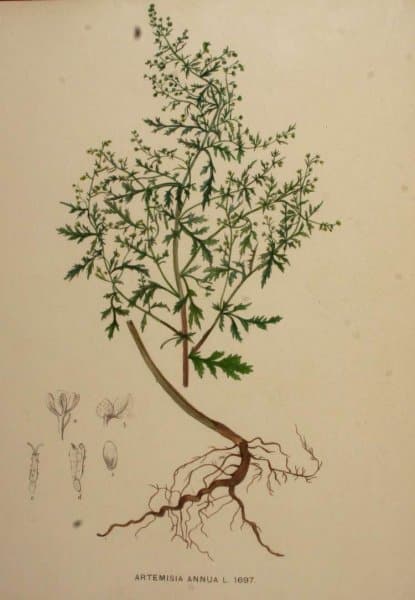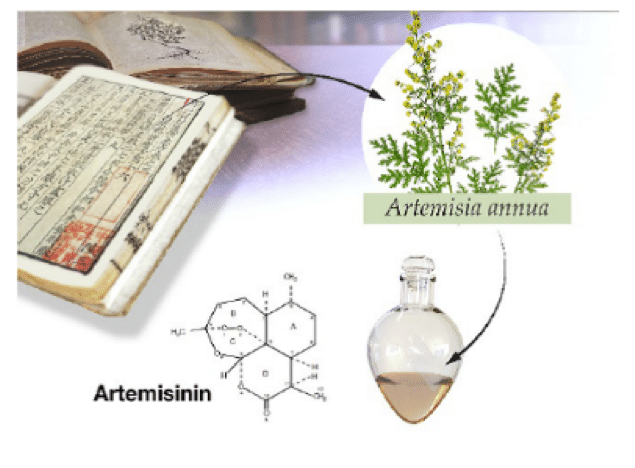Les plantes

The plants
First and foremost, it should be noted that the term « Artemisia » often used by La Maison de l’Artemisia refers to the plant species Artemisia afra and Artemisia annua. This generic term is not written in italics so as not to confuse it with the genus « Artemisia » which comprises several hundred other species.
Distinction between Artemisia annua and Artemisia afra:
Artemisia annua is an herbaceous plant that has been used for 2000 years in Traditional Chinese Medicine to prevent and treat intermittent fevers (malaria) and other parasitic diseases. It is an annual plant and must therefore be sown every year in order to be harvested before flowering. This makes it demanding in terms of care.
Artemisia afra is a perennial bush native to South East Africa, used by Traditional Medicine practitioners for centuries to prevent and cure malaria and other parasitic diseases. It is a perennial plant which can be harvested as needed throughout its growth. However, it is difficult to produce viable seeds. This is why it is mainly propagated by layering or cuttings.
Traditional use
Artemisia annua
Artemisia annua L
is native to China, its Chinese name Qing Hao, literally means “green grass”.
In China, knowledge of the medicinal virtues of wormwood plants goes back a long way. This is particularly true for the species Artemisia annua and Artemisia apiacea.
The first mention of these medicinal plants and their use – the treatment of oozing haemorrhoids – was found in the tombs of the Han Mawangdui dynasty on a silk scroll dated 168 BC.
200 A.D.: 1st writing of the Shen Nong Ben Cao Jing, the founding book of Chinese herbal medicine, the sum of the knowledge of herbal medicine transmitted orally for centuries (Shou-zhong, 1997). The text states that, among other properties, Qing Hao “relieves heat lodged in joints”, which could be interpreted as the treatment of feverish diseases.
Zhang Ji (150-219 A.D.) in his classic text on “Cold Damage” (Shang Han Lun) recommends a decoction of Qing Hao to treat fevers with sweating and jaundice (Mitchell et al., 1999).
The physician-philosopher Ge Hong was the first to mention the anti-fever properties of these plants in his “Manual of Prescriptions for Emergency Treatment” in the early 4th century. The method of preparation was a cold water extraction: a handful of the aerial parts of the plant was to be soaked in two Sheng (about 1-2 l) of water, and the juice was to be drunk in its entirety (Tu, 1999).
The use of Artemisia annua as a major medicine for intermittent fevers appeared in the Song Dynasty (960-1279). The decoction of Qing Hao is described in the “General Medical Collection of the Royal Benevolence”. The expansion of rice fields at that time increased the ideal breeding grounds for mosquitoes carrying the malaria parasite.
It is only in the 16th century that the famous physician and naturalist Li Shizhen, during the Ming dynasty, describes the use of Qing Hao to treat paroxysmal malaria fever in his Ben Cao Gang Mu (Compendium Materia Medica).
At the end of the 18th century, Wenbing Tiaobian used Qing Hao in a mixture with other plants depending on the type of fever (cited in Laughlin et al., 2002).
Leaves and stems of A. annua are also burned in China as an insecticide fumigant to kill mosquitoes (Foster and Chongxi, 1992).
During the first half of the 20th century, the colonisation of China led to a devaluation of traditional knowledge and a disregard for the herbal medicine of the Empire in favor of Western medicine, and it is only in the context of the post-World War II era that the virtues of Artemisia annua are once again brought to light.
In the 1960’s, faced with a strong resurgence of malaria in the southern provinces, the Chinese authorities launched the “523 Program” which consisted in exploring the potential of traditional Chinese herbal medicine. Scientists from the Institute of Materia Medica of Beijing discovered a region in the south without malaria where the inhabitants drank a preparation based on Artemisia annua as soon as the first symptoms of malaria appeared. The consultation of traditional bencao treatises by Chinese sDuring the Vietnam war, the Viet Cong, which operated in swamps, rice fields and tropical forests, lost more soldiers to infected mosquito bites than to American bullets and bombs. Hô Chi Minh then turned to China and the massive sending of Artemisia annua and Artemisia apiacea allowed the North Vietnamese soldiers to protect themselves from the malaria threat.
In 1972, the artemisinin molecule was isolated from the plant’s leaves. Chinese medicines based on artemisinin were only distributed in the Beijing area (Vietnam, Cambodia and some African countries).
During the 1980s, health authorities became aware of the increasing resistance of the malaria parasite to quinine derivatives. It was at this time that artemisinin became known throughout the world and aroused the interest of large pharmaceutical companies, which began to manufacture semi-synthetic derivatives and introduced the first drugs (water-soluble artesunate, liposoluble artemisinin) on the market in 1986.
In 2015, one of the researchers of the 523 program, Professor Tu Youyou, was awarded the Nobel Prize in Medicine for the discovery of artemisinin.
While the WHO and pharmaceutical companies have encouraged and supported research on the artemisinin molecule, they have not promoted research on the potential of the plant itself
Bibliography
2. M. Wilcox and al., Artemisia annua as a Traditional Herbal Antimalarial in CRC Press, 2004
3. E. Hsu, The history of qing hao in the Chinese materia medica, Transactions of the Royal Society of Tropical Medicine and Hygiene (2006) 100, 505—508
4. Jean-Luc Galabert “Artemisia, de la malaria au coronavirus” Izuba Editions




Artemisia afra
Artemisia afra has been much more discreet in history than its Chinese cousin. The virtues and uses of Artemisia afra were transmitted orally within the African societies that included it in their pharmacopoeia. This plant grows naturally in the mountainous regions of southeast Africa between 1,500 and 3,000 meters above sea level.
Artemisia afra Jacq. is found on the plateaus of Eastern Africa, from South Africa to Ethiopia. Compared to Traditional Chinese Medicine, Traditional African Medicine is much less documented due to the cultural and linguistic fragmentation of the vast African continent.
Artemisia afra is used in the traditional pharmacopoeia of many ethnic groups who call it “Umhlonyane”, “Mhlonyane”, “Lanyana”, “Lengana”, “Fivi”, “Lusange”, “Lunyaga”, …
It is used to treat a wide variety of ailments ranging from respiratory pathologies (coughs, colds, sore throat, flu, asthma), to gastrointestinal disorders (dyspepsia, intestinal parasitosis, gastritis), topical use for skin disorders (ringworm, boils, acne, hemorrhoids, herpes, wounds), gynecological problems (dysmenorrhea, amenorrhea, menstrual cramps) and fever.
A. afra herbal tea s widely used in the fight against malaria (sometimes in association with Lippia javanica), pulmonary tuberculosis and diabetes. It is also used in inflammatory diseases (rheumatism, gout) and neurological disorders such as epilepsy.
Bibliography
2. Some Medicinal Forest Plants, FAO Forestry Paper 67, 1986
3. N.Q. Liu, et Al., Artemisia afra: A potential flagship for African medicinal plants ? South African Journal of Botany 75 (2009) 185–195 https://doi.org/10.1016/j.sajb.2008.11.001
4. JPatil GV, Dass SK, Chandra R (2011) Artemisia afra and Modern Diseases. J Pharmacogenom Pharmacoproteomics 2:105. doi:10.4172/2153-0645.1000105

Different types of preparations based on Artemisia are used internally and externally.
Infusion: typically, a quarter cup of fresh leaves is added to a cup of boiling water and left to infuse for 10 minutes. The mixture is then filtered and the resulting infusion is sweetened with honey. This preparation is taken orally to relieve most ailments. The hot infusion is also used as a gargle to treat sore throats. The infusion of a double handful of leaves in one litre of water is given as an enema to treat fever.
Decoction : plant boiled for 10 minutes is a bouillie pendant 10 min, remedy for fever which can also be applied as a lotion on glandular or skin inflammations, herpes and lesions. It can be used to bathe parts of the body (external auditory canal, haemorrhoids). An infusion of leaves or a root decoction is also used for the treatment of diabetes in the Eastern Cape Province of South Africa.
Inhalation: respiratory ailments and sore throats are treated by inhaling steam from boiling leaves and sometimes smoke from burning leaves.
Cataplasme: or poultice made from leaves and ointments is applied to relieve neuralgia, glandular and skin inflammations (mumps), or ringworm and placed on the abdomen to treat baby colic.
Alcohol extract: It is also possible to reduce colic by administering a tincture made of leaves soaked in brandy.










